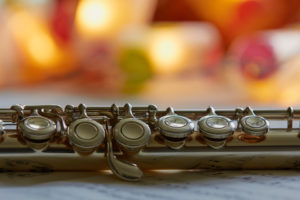How To Clean A Rusty Flute
The vast majority of flutes are made up of nickel, silver or gold, so it's no surprise that your flute is sure to deal with the common problems associated with metal instruments from time to time. One of these problems being that you may experience browning or even blackening of your flute without proper care and maintenance. If this is something you are currently experiencing, you may be wondering what this strange discoloration is caused by, how to fix it, and how to prevent it in the future.
Over time, your flute may turn brown or even blackened, caused by tarnishing as the sulphur in the air reacts with the silver. To clean a tarnished flute, start by rubbing down the flute with a silver polishing cloth and then use an anti-tarnish silver polish with a microfiber cloth to rub the area until the tarnish slowly disappears. This polish also prevents tarnishing in the future without damaging your flute's exterior or leaving smudge prints and oil residue.
All in all, with a bit of polish and the right cloths to assist you, the cleaning process to remove tarnish is relatively simple. Still, the questions remain as to why this happens in the first place, what the color change is caused by, how to clean the entire flute using said polishing process, and what exactly would happen if you chose not to clean the tarnished flute. To answer these questions and more, let's first take a look at the tarnishing process and why discoloration happens to begin with to work our way up from there.
Why is my Flute Turning Black?
 The actual process that causes this browning or blackening is the reaction which happens from silver sulfide. This silver sulfide is created when the elemental silver flute reacts with hydrogen sulfide gas. You can find this sulphur in many ways, ranging from the glue used to assemble the case that your flute is in, the breath that you expel onto your flute when playing it, your natural body oils, rubber bands used to wrap around the flute, and even simply in the air of your city residence.
The actual process that causes this browning or blackening is the reaction which happens from silver sulfide. This silver sulfide is created when the elemental silver flute reacts with hydrogen sulfide gas. You can find this sulphur in many ways, ranging from the glue used to assemble the case that your flute is in, the breath that you expel onto your flute when playing it, your natural body oils, rubber bands used to wrap around the flute, and even simply in the air of your city residence.
When the flute is left out for too long or you do not properly clean your flute's head joint often, you are sure to see the first signs of tarnishing and browning. The longer you let this sit, the darker the flute's exterior will get. This is exactly why cleaning your flute and keeping your flute in a safe place are both highly important in order to increase the lifespan of your instrument and the pristine quality of it likewise.
How do I Clean a Tarnished Flute?
 All in all, the cleaning of a tarnished flute is relatively simple as it just takes a silver polishing cloth, a microfiber cloth, and some anti-tarnish silver polish. You will also need to be able to take your flute apart but this process is also quite simple if you know exactly how to do it without damaging your flute or losing integral pieces.
All in all, the cleaning of a tarnished flute is relatively simple as it just takes a silver polishing cloth, a microfiber cloth, and some anti-tarnish silver polish. You will also need to be able to take your flute apart but this process is also quite simple if you know exactly how to do it without damaging your flute or losing integral pieces.
- To begin, put a small amount of silver polish on your cloth and start rubbing in a circular motion on the surface of your flute. You will begin to see the tarnish slowly disappear.
- Once the tarnish is only left on the keys and within the nooks and crannies of your flute, hold the footjoint from the ends and twist it away from the body of the flute.
- Next, separate the headjoint from the body in a similar motion.
- Lastly, clean all of these parts individually and reassemble your flute once done.
You can also use a chemical system that attracts the sulfide layer to aluminum. This process is far better if you don't want to remove a layer of silver when cleaning off the tarnish. However, this is not as simple of a process and may need to be done by professionals instead of yourself.
One of the ultimate tips you can utilize to reduce flute tarnish in the future is to use charcoal. Although this may seem strange, anti-tarnish charcoal strips are highly common in the flute world as they absorb sulfur in the air and make it far less likely that tarnishing will occur.
What Would Happen if I Didn't Clean my Tarnished Flute?
 One of the most common questions that individuals have regarding flute tarnish is whether or not you need to remove the tarnish immediately. Fortunately, flute tarnish truly is not something that will impede upon your ability to play your flute or the sound that your flute makes.
One of the most common questions that individuals have regarding flute tarnish is whether or not you need to remove the tarnish immediately. Fortunately, flute tarnish truly is not something that will impede upon your ability to play your flute or the sound that your flute makes.
However, if the tarnish is paired with corrosion or rust, you could very well end up with holes in your flute that will render the flute useless over time. This is one of the main reasons that people simply clean the tarnish from their flute regularly will notice any kinds of serious damage before they become irreparable.
According to one expert on Stack Exchange, "There will be no sound change from a tarnished flute. If it is corroded, you may have a problem. It is more likely that corrosion in the key mechanisms would impede your playing."
Essentially, the main reason that individuals clean their tarnished flutes and remove the tarnish is less about it damaging the flute and more about the appearance of said flute as well as the fact that tarnish buildup is more difficult to clean than simply keeping up with it regularly.
Can a Gold Flute Avoid Tarnishing Better?
 Another big question that people have regarding flute tarnish is whether or not a different metal would respond differently and perhaps even better. Although this in theory is a good concept, the truth is that even gold plated silver flutes do tarnish if not cared for properly.
Another big question that people have regarding flute tarnish is whether or not a different metal would respond differently and perhaps even better. Although this in theory is a good concept, the truth is that even gold plated silver flutes do tarnish if not cared for properly.
On top of this, a full gold flute can cost anywhere between $40-50k which is obviously not an option for most flautists. For this reason, if you are wanting a more resilient flute at a reasonable price in order to avoid tarnish with less upkeep, you'll want to look at flutes made from an alloy or that are gold or silver plated. These instruments will still have the luster of the precious metal but will be less maintenance.
However, no matter what flute material you choose, you will still want to use cleaning supplies frequently to keep your flute in good condition, pay attention to sulfur in the air, and use charcoal strips to avoid tarnish altogether.
The Final Notes
In the end, caring for and playing your flute both stem from the same passion. All it takes is a bit of time, focus, and understanding exactly how to keep your flute tarnish-free to extend the life of your flute and keep the silver appearance present for years to come.
Lastly, if you're interested in other ways to keep your flute clean, feel free to check out our other flute cleaning articles today!
How To Clean A Rusty Flute
Source: https://cleanmyinstrument.com/tarnished-flute/#:~:text=To%20clean%20a%20tarnished%20flute,until%20the%20tarnish%20slowly%20disappears.
Posted by: saxontiontems.blogspot.com

0 Response to "How To Clean A Rusty Flute"
Post a Comment